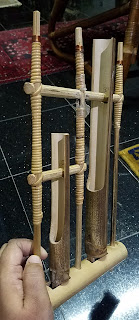In 2019 all the talk is about Digital India and the ongoing onslaught of the fourth industrial revolution a.k.a Industry 4.0. What is that, you ask?
It's about having systems talking to each other
through wireless connectivity,
in the land of cheap smart phones,
where data is the cheapest in the world,
accessible to all and sundry,
where decision making is automated,
based on input from sensors,
leading to smart cities and smart operations
with increased efficiency and
jobs are Bangalored to bots this time!
Let your imagination run wild and
add your own happy (and sad) thoughts here...
Newspapers are already killing it with articles about how this will lead to massive unemployment in the near future.
Ground reality however is grounded knee-deep, unable to take off on such wild imaginative excursions. Feel free to blame the BBMP for potholes in network connectivity as well, in the midst of a bustling neighborhood in South Bangalore. Realized this when I visited ICICI Bank along with my mother. We came with a simple request - please remove my deceased father's name from a joint account where my mother was the primary account holder.
The Govt. of India claimed 80% of Indian citizens had bank accounts in Mar 2017, with 157.1 crore accounts in different banks. That year, the death rate was 0.73%. Let's assume each deceased person held an account. Then 1,15,00,000 (i.e. 1.15 crore) bank accounts needed to be updated. One moment... let's digest that number. Given this large number it's but natural if you assume this is a common for banks, with standardized procedures for handling such cases in 2019.
Ummmm ... no! Apparently, a deceased account holder isn't something this branch is used to dealing with. None less than an assistant bank manager was worthy of the task! That's even more surprising since the branch is located in Jayanagar, Bengaluru, of late a pensioner's paradise, home of many rich (maybe?) and retired (definitely!) seniors and super-seniors.
Turns out even if you have a sole or survivor type of joint account, ICICI wants you to close the joint account held with the deceased person and open a new account for yourself. Sure, en tondre illa! Just didn't think it'd take 1.5 hours and involve filling out lengthy forms, signing 15 autographs and waiting eagerly & endlessly for the staff to process it, amidst their loud, desperate cries for help to assistants who scrambled around the bank pointlessly, disappeared indefinitely, reappearing surreptiously by the time their name was called out a sixth time. The icing on the cake ... the bank asked for a cheque from another bank for KYC (Know Your Customer), after my mother had maintained a twenty year long relationship with them.
In the age of self-driving cars, when ISRO is simultaneously reconciling with Chandrayaan-2's just-miss of an autonomous soft moon-landing while planning to send humans on a Gaganyaan, ICICI is struggling to transform its staff's 90's era paper-pushing style of working since it's unable to keep it's intranet alive and accessible. Someone, somewhere must have been meditating in a Himalayan cave all this while!










